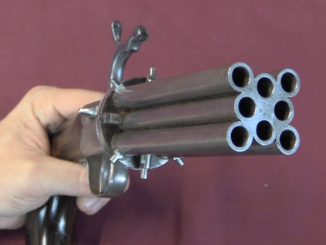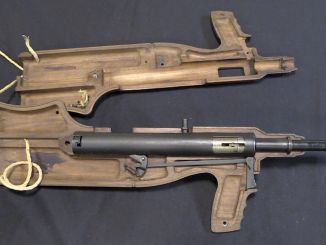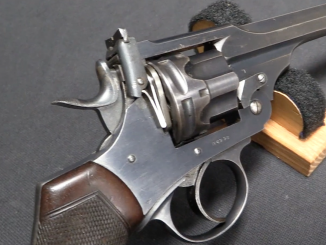The Vickers is quite simply the best heavy machine gun ever made.
Related Articles

Revolver
Oversized 8-Barrel British Pepperbox Revolver
The typical pepperbox revolver is a sleek and small .31 caliber double action pocket gun, like the Allen & Thurber standard type. This one, however, is anything but typical. This London-made gun is a far […]

Prototype
Viper MkI: A Simplified Steampunk Sten
The Viper Mk I was an experimental submachine gun developed in the UK for use by military policemen in post-WW@ occupation West Germany. It was a simplified Sten gun (full-auto only, without the semiauto option […]

Revolver
Beautiful Webley WS Target in 22 Rimfire
Webley introduced the WS model revolver in 1902, combining the square grip of the earlier WG model with the mechanical system of the Mark IV government revolver. The new WS pattern was available in both […]

Wo doesn’t love a gun that pees?! I was curious about the cocking handle, is there no way to fasten it down or is it recipricating and as such has to travel back and forth, to prevent it wacking into your fingers like it does?
Ah, You dumped the water. What was wrong with making authentic Tommy Tea out of it.
Assuming it’s (practically) the same as a 1919 Browning, once you thoroughly mix the water with a dash of antifreeze and gun oil…it tastes really bad.
Don’t resemble Picards Earl Gray much.
Gives you the poops for about the subsequent week, too.
But then, who really knows? How ’bout you give it the field test for us and get back with the results?:):):)
Next up, researching the “M1-Thumb” Real? Or just a left-wing propaganda?
Get back to us, especially with video, if possible.
YouTube awaits:):):)
Not to mention the Comedy Channel:):):)
…Hard to make tea from a 1919 Aircooled Browning. Perhaps you meant the 1917 ?
You’re right, my bad.
We had very few water-cooled anythings in those peaceful (?) days of the late 1960’s. A4’s, A6’s, M60’s and the like instead.
The tea and the instant coff still tasted not-so-good mixed with petroleum products in any case but we found one or two six-rounders would toast up an M60 barrel nicely enough to warm chilled hands and fingers.
Never underestimate the creativity of a too-hot or too cold line infantry jock, of any nationality.
Assuming it’s (practically) the same as a 1919 Browning, once you thoroughly mix the water with a dash of antifreeze and gun oil…it tastes really bad.
Don’t resemble Picard’s Earl Gray much.
Gives you the poops for about the subsequent week, too.
But then, who really knows? How ’bout you give it the field test for us and get back with the results?:):):)
Next up, researching the “M1-Thumb” Real? Or just a left-wing propaganda?
Get back to us, especially with video, if possible.
YouTube awaits:):):)
Not to mention the Comedy Channel:):):)
Hey Ian is this particular gun the one you are selling?
Also i have always been curious how they filled the belts thanks for showing that
Super vidio!!!!!!!!!!!!! Great info.
The second “tranche” of Divisions some 13 in all, I think these were the late Spring early summer arrival divisions that were sent to France but not committed to action until the late summer? were supposedly armed with Colt Made Vickers guns in 30-06. I have not seen a lot of documentation on this except for mentions in post war reports, but these Divisions also were issued CSRG 1918s. The last tranche of Divisions came with B.A.R.s and Browning 1918 although the shortage of Browning 1917s may have led to other guns. I don’t know that I have ever seen a photo of US troops using Colt/Vickers guns although it appears that nearly 8,000 were issued to US troops in WWI. In addition about 2,500 more were delivered as aircraft guns. With a production total of 12,000 here in the states one can see why so many (relatively speaking) sideplates may have survived. Colt also made Maxim guns for the Russians. This is an excellent article on the Colt Vickers of WWI. http://www.sadefensejournal.com/wp/?p=756
Ian,
All joking aside, really nice video on the Vickers. Thanks.
So a British Australian American mg firing Russian ammo loaded bij a Finnish tool! Great and way to short video.
“Vickers is quite simply the best heavy machine gun ever made.”
I am confused as always: If this is heavy machine gun, then .5″ Vickers MG is … machine gun?
.50 Vickers is also an HMG.
“Heavy Machine Gun” is a mission defined term. The ground HMG’s job is providing sustained supporting fire for long periods of time. This is why most of them were water-cooled and practically all of them were belt-fed.
Most HMG’s have been chambered for standard rifle cartridges. In fact, one of the earliest, the U.S. Army’s 1865-70 Gatling, first chambered the briefly-used .58 rimfire round (used in very early Springfield “trapdoor” conversion breechloaders) and then the .50-70. Later versions chambered the .45-70, and by the Spanish-American War, .30-40 (U.S. Krag).
The .50 caliber was developed by John Moses Browning for the U.S. Army during the latter part of WW1 mainly as an anti-aircraft weapon with a secondary anti-tank role. At the same time, the German Reichswehr was developing their own 13mm HMG as purely an anti-tank weapon. (They had a lot more “tank problems” than the Allies did up to the Armistice.) It fired the same round as the Mauser “Tank-Gewehr” single-shot bolt-action anti-tank rifle.
Not long before the Armistice, the U.S. Army (for which read “General Pershing”)found out about the German 13mm round, which was significantly more powerful than our first experimental .50 cartridge, and told Browning and Army Ordnance to come up with a .50 caliber equivalent and build a machine gun around it.
The result was the M1922, a water-cooled gun that was the ancestor of the M2 (ground) and M3 (aircraft) air-cooled “Fifties” of WW2.
BTW, water-cooled .50s were quite common as “light” AA guns throughout WW2. With the U.S. Navy.
cheers
eon
The Brit .5″ cartridge for the Vickers was different than the US. It was 12.7 x 81. The US cartridge was 12.7 x 99 and apparently considerably more powerful. The 15mm Besa machine gun with its very powerful round was Mark VIc tank which saw a lot of use early in the war, especially in France and Greece. The Matilda Mark I still used the Vicker .5″ or .303. I thought the Brit navy went with the .59 Besa but apparently I was incorrect.
“13mm HMG as purely an anti-tank weapon”
You mean weapon known as TuF-MG 1918?
https://de.allbuch.online/wiki/TuF-MG_1918
Its name implies that it was double purpose (Tank und Flieger)
WRT The Mad Minute, the marksmanship skill of the British Army in the summer and fall of 1914 is often exaggerated. The target(s) they were shooting at were literally phalanxes of Germans. There are photos of these massed German formations in Max Hasting’s book “Catastrophe”. And of course the vast majority of rounds fired missed.
The Canadian Army’s infantry rifle qualification still contains the essence of the Mad Minute- 300 m, prone, fire ten shots reload and fire five- but with a 5.56mm rifle with a 4X optic and mags instead of stripper clips it’s lost much of it’s urgency.
And the Brits were hardly only one, some A-H units were drilled in the rapid fire with Mannlicher straight-pull, up the 20 rounds per minute. Problem with it was that it consumed prodigious amounts of ammo, and logistics could not keep and I guess neither could British ones.
BTW, all 1st call Serbian army servicemen serving as a riflemen in infantry were expected to fire 15 aimed shots per minute, so it was hardly something unique to British or Lee-Enfield.
IOW, it was a gimmicky thing, with very limited utility, raised to the status of the legend by exaggeration and Anglo-centrist history of the WW 1.
Is it an exaggeration to say we won two world wars and one world cup, I think not.
A gross exaggeration as to the two World Wars. France carried the weight in WWI and the US and Soviet Union did the same in WWII.
I know. I was parodying native jingoism, I suppose.
Oh. Went right over my head, sorry.
It’s a football chant, not to worry.
Hi Ian, I have paperwork running on a Vickers right now. Among the crap ton of accessories it came with included a PKM belt loader and belts. How do I check to see what barrel or barrels, (it came with five), might be in 7.62×54? Also, anything different with the feed block, (it came with four)? Thank you Gun Jesus!